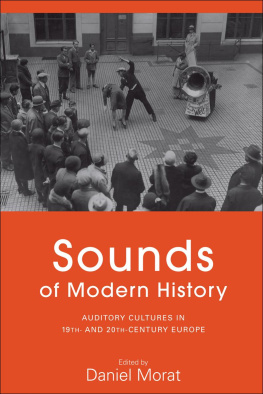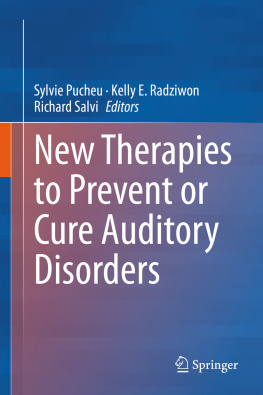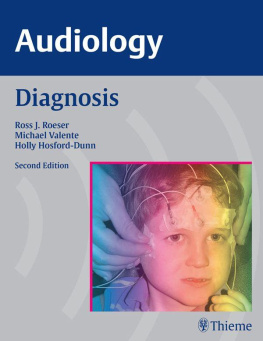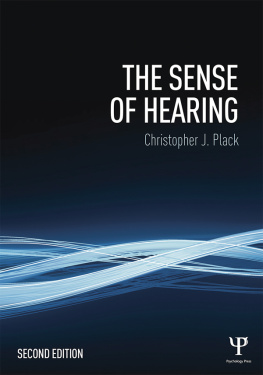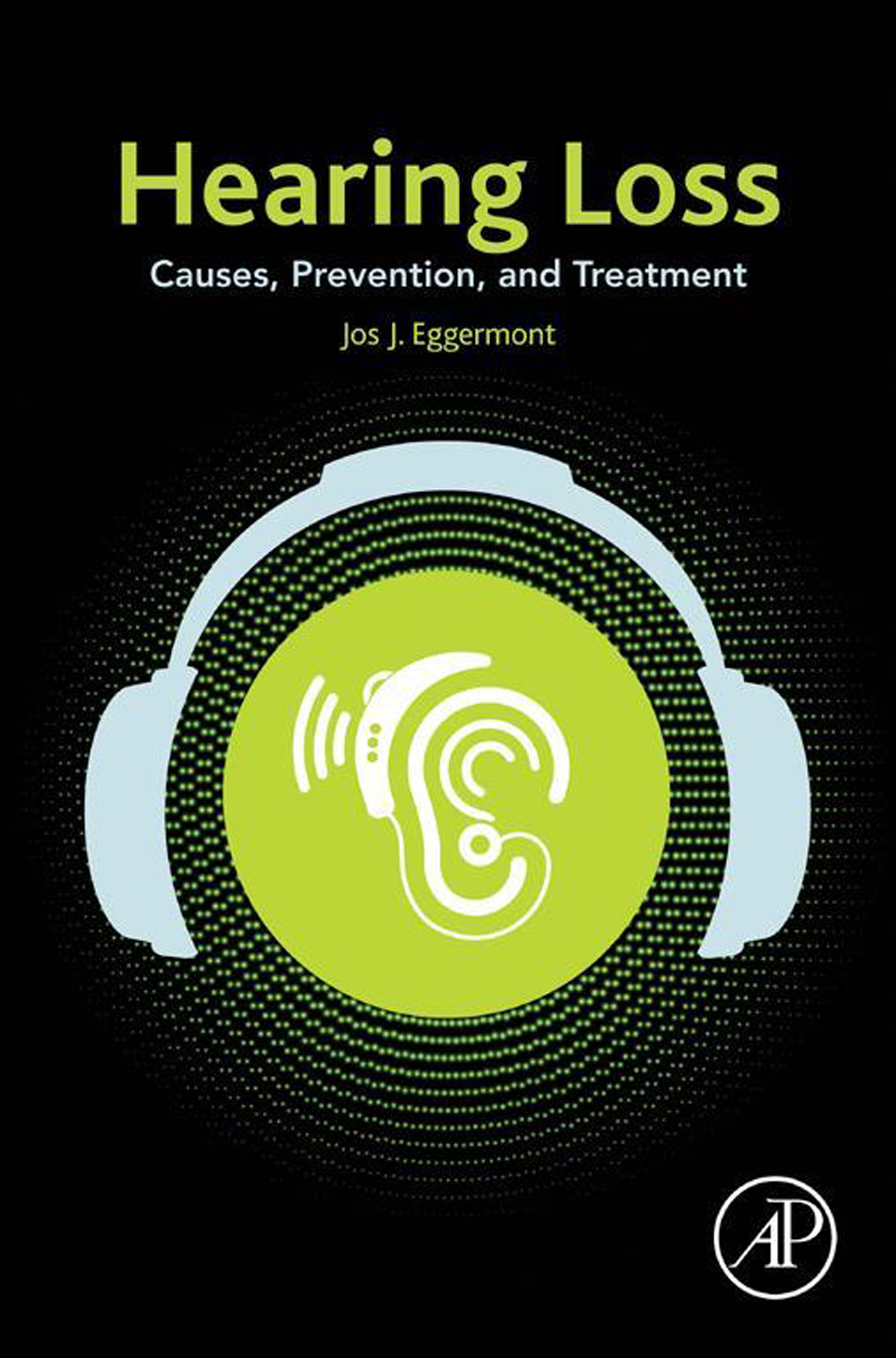Table of Contents
List of tables
- Tables in Chapter 4
- Tables in Chapter 5
- Tables in Chapter 7
- Tables in Chapter 8
- Tables in Appendix A
List of illustrations
- Figures in Chapter 1
- Figures in Chapter 2
- Figures in Chapter 3
- Figures in Chapter 4
- Figures in Chapter 5
- Figures in Chapter 6
- Figures in Chapter 7
- Figures in Chapter 8
- Figures in Chapter 9
- Figures in Chapter 10
- Figures in Chapter 11
- Figures in Chapter 12
- Figures in Chapter 13
- Figures in Appendix A
Landmarks
Table of Contents
Hearing Loss
Causes, Prevention, and Treatment
Jos J. Eggermont
University of Calgary, Calgary, AB, Canada

Copyright
Academic Press is an imprint of Elsevier
125 London Wall, London EC2Y 5AS, United Kingdom
525 B Street, Suite 1800, San Diego, CA 92101-4495, United States
50 Hampshire Street, 5th Floor, Cambridge, MA 02139, United States
The Boulevard, Langford Lane, Kidlington, Oxford OX5 1GB, United Kingdom
Copyright 2017 Elsevier Inc. All rights reserved.
No part of this publication may be reproduced or transmitted in any form or by any means, electronic or mechanical, including photocopying, recording, or any information storage and retrieval system, without permission in writing from the publisher. Details on how to seek permission, further information about the Publishers permissions policies and our arrangements with organizations such as the Copyright Clearance Center and the Copyright Licensing Agency, can be found at our website: www.elsevier.com/permissions.
This book and the individual contributions contained in it are protected under copyright by the Publisher (other than as may be noted herein).
Notices
Knowledge and best practice in this field are constantly changing. As new research and experience broaden our understanding, changes in research methods, professional practices, or medical treatment may become necessary.
Practitioners and researchers must always rely on their own experience and knowledge in evaluating and using any information, methods, compounds, or experiments described herein. In using such information or methods they should be mindful of their own safety and the safety of others, including parties for whom they have a professional responsibility.
To the fullest extent of the law, neither the Publisher nor the authors, contributors, or editors, assume any liability for any injury and/or damage to persons or property as a matter of products liability, negligence or otherwise, or from any use or operation of any methods, products, instructions, or ideas contained in the material herein.
British Library Cataloguing-in-Publication Data
A catalogue record for this book is available from the British Library
Library of Congress Cataloging-in-Publication Data
A catalog record for this book is available from the Library of Congress
ISBN: 978-0-12-805398-0
For Information on all Academic Press publications visit our website at https://www.elsevier.com/books-and-journals

Publisher: Mara Conner
Acquisition Editor: Melanie Tucker
Editorial Project Manager: Kathy Padilla
Production Project Manager: Sue Jakeman
Designer: Mark Rogers
Typeset by MPS Limited, Chennai, India
Preface
Jos J. Eggermont
Hearing is often taken for granted, and so its functions become noted only when they start to deteriorate. Prior to that there may already be warning signs in the form of tinnitus. Suddenly, one faces problems understanding speech, especially in noisy environments. This is annoying because those environments often accommodate social encounters, cocktail parties, sports venues, and bars. Hearing loss is foremost a communicative disorder, but it also diminishes the warning function that it normally has.
Hearing allows us to localize threatening sounds such as a car speeding in our direction or a barking dog close by. Sound localization also allows us to orient to interesting sounds, for instance to distinguish a musical instrument in an orchestra, or a voice in a cocktail party, and focus our attention to it.
The function of hearing is clearly present in all vertebrates. Even if we do not know exactly what they hear, we can infer it from the sounds they make. Bird song can be annoying (magpies) or pleasant (canaries) but we can assume that their conspecifics can hear it. Animals that normally do not make much noise such as cats have sensitive, broad frequency, hearing and use it to localize the scurrying mice and vocal songbirds. One can conversely assume that the potential prey uses hearing to avoid the predators.
Everyone who has heard a chorus of frogs or cicades understands the communication and socialization aspect of sound, particularly if the underlying intention is to call potential mates. Thus, hearing serves to localize and identify sounds emitted by conspecifics that may lead to mating, in humans potentially after socializing and chatting. Hearing warns about danger, from predators to approaching vehicles, and most of these functions are severely diminished in case of hearing loss.
Why do we have hearing loss? If we would be able to ask this to a frog or a finch, the answer would potentially be what is hearing loss? Just as sharks have a batch of teeth in reserve to replace the worn out current set, non-mammalian vertebrates can replace the hair cells in the inner ear when they are damaged by loud sounds or aging. Mammals have lost this gift, because evolution dictated that the ability to hear sounds with higher frequencies had more advantage than loosing some hearing sensitivity. Of course noise trauma was rare in the evolutionary period. The super-numerous replacement cells were converted to form a high-frequency region in the inner ear allowing hearing for frequencies above say 510 kHz, the upper region in birds. Currently, a large effort is put into finding out how to tweak genetic mechanisms to regain the possibility to replace damaged cochlear hair cells and so cure hearing loss and deafness.
My approach to the topic of this book is that the substrate of hearing sensitivity loss is in the ear whereas that for hearing problems is in the brain. The combination of the two aspects forms the communication disorder problem. Any amelioration has to deal with restoring the hearing sensitivity via hearing aids or cochlear implants, but also has to deal with the cognitive problems that result from the hearing loss or may be separate there from as in aging. We also will look at the feedback from the brain to the ear, which may result from attention and stress, through the corticofugal activity to midbrain, brainstem, and even the cochlea. Such central action may include protective effects for noise-induced hearing loss and presbycusis.
The book is comprehensive in the sense that it may be used as a stand-alone text in last year undergraduate and graduate courses in audiology. It starts with three basic science chapters, refreshing and updating knowledge about the auditory system, brain plasticity, and multisensory interaction. These chapters form the basis for training approaches in cochlear-, brainstem-, and midbrain-implant use and may also help understanding acclimatization effects on hearing aid use.


